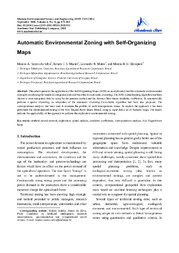Automatic environmental zoning with self-organizing maps.
Automatic environmental zoning with self-organizing maps.
Autoria: SILVA, M. A. S. da; MACIEL, R. J. S.; MATOS, L. N.; DOMPIERI, M. H. G.
Resumo: This article presents the application of the Self-Organizing Maps (SOM) as an exploratory tool for automatic environmental zoning by combining the handle of categorical data and the other for automatic clustering. The SOM online learning algorithm had been chosen to treat categorical data by using the dot product method and the Sorense-Dice binary similarity coefficient. To automatically perform a spatial clustering, an adaptation of the automatic clustering Costa-Netto algorithm had been also proposed. The correspondence analysis had been used to examine the profiles of each homogeneous zones. To explore the approach it has been performed the environmental zoning of the Alto Taquari River Basin, Brazil, using as input data a set of thematic maps. The results indicate the applicability of the approach to perform the exploratory environmental zoning.
Ano de publicação: 2018
Tipo de publicação: Artigo de periódico
Unidade: Embrapa Agricultura Digital
Observações
1 - Por padrão são exibidas publicações dos últimos 20 anos. Para encontrar publicações mais antigas, configure o filtro ano de publicação, colocando o ano a partir do qual você deseja encontrar publicações. O filtro está na coluna da esquerda na busca acima.
2 - Para ler algumas publicações da Embrapa (apenas as que estão em formato ePub), é necessário ter, no celular ou computador, um desses softwares gratuitos. Sistemas Android: Google Play Livros; IOS: iBooks; Windows e Linux: software Calibre.
Acesse outras publicações
Acesse a Base de Dados da Pesquisa Agropecuária (BDPA) para consultar o acervo completo das bibliotecas da Embrapa.

